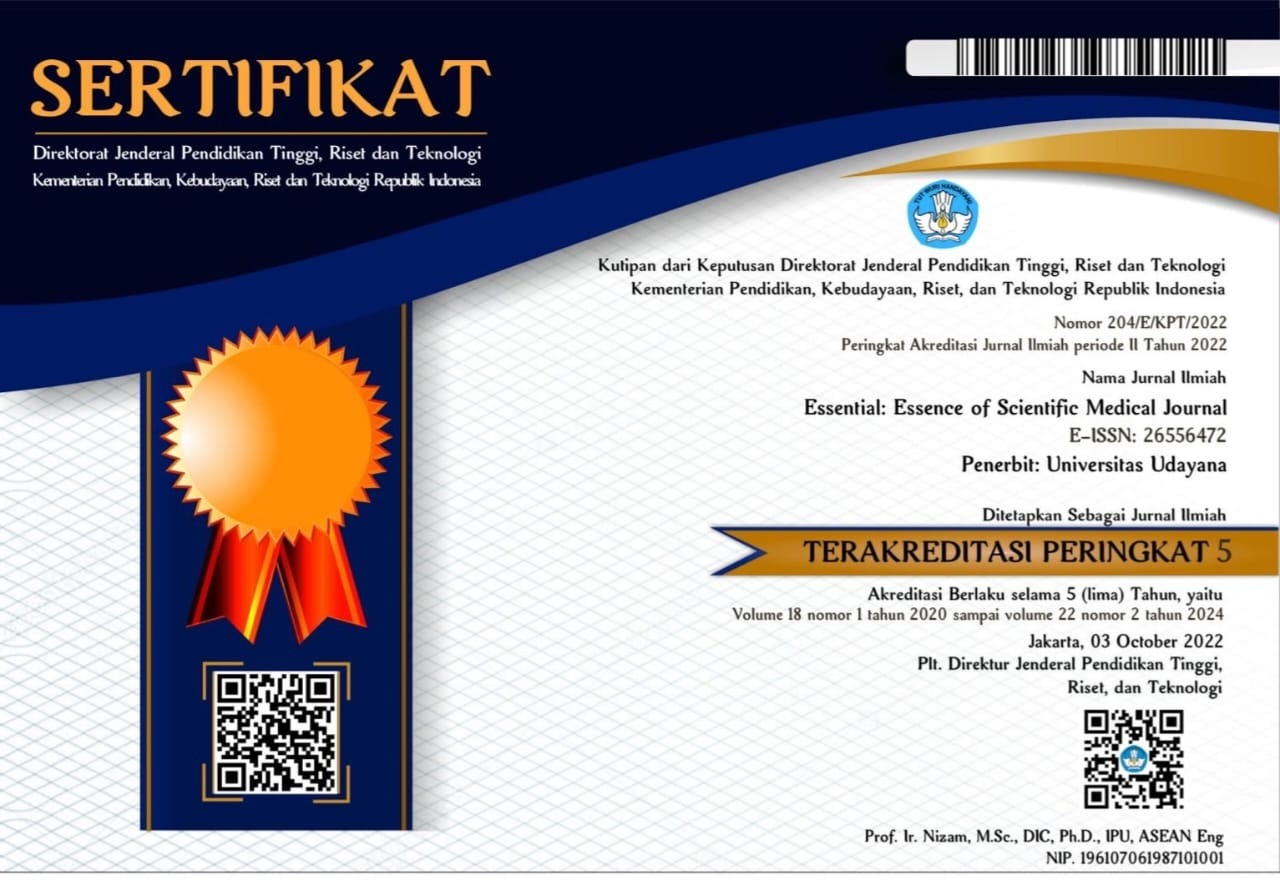Potensi dan Keamanan Penggunaan Magnetic Resonance Imaging-Guided Focused Ultrasound Sebagai Terapi Penyakit Parkinson
Abstract
Pendahuluan: Penyakit Parkinson (PP) merupakan penyakit neurodegeneratif kompleks yang terdiri dari berbagai gejala motorik dan non-motorik seiring dengan perkembangan penyakit. Peningkatan beban sosial ekonomi dan konsekuensi yang besar memerlukan penanganan tepat yang harus disesuaikan dengan prioritas dan kebutuhan masing-masing individu. Kombinasi gejala progresif PP dan efek samping pengobatan juga dapat menyebabkan penurunan kualitas hidup. Terapi yang seimbang dalam manajemen gejala dan menghindari efek samping pengobatan diperlukan dalam mengelola PP.
Metode: Tinjauan ini merangkum uji klinis yang memenuhi kriteria inklusi dari hasil pencarian yang dilakukan di PUBMED, Cochrane, ScienceDirect, dan EuropePMC, dan disusun menggunakan kriteria PICOS.
Pembahasan: Sebanyak 14 studi dimasukkan dalam tinjauan literatur. Fungsi motorik dan kualitas hidup pasien menunjukkan peningkatan yang signifikan setelah penggunaan prosedur MRgFUS. Namun, MRgFUS juga menyebabkan banyak kejadian buruk pada pasien baik karena kerangka stereotaktik atau gejala neurologis.
Simpulan: MRgFUS merupakan terapi non-invasif yang memiliki potensi tinggi untuk meningkatkan fungsi motorik dan meningkatkan kualitas hidup pasien PP, tetapi dapat menyebabkan sejumlah kejadian buruk, baik selama prosedur maupun setelah prosedur.
Downloads
References
2. Gonzalez-Latapi P, Bayram E, Litvan I, Marras C. Cognitive impairment in parkinson’s disease: Epidemiology, clinical profile, protective and risk factors. Behav Sci (Basel). 2021;11(5).
3. Bloem BR, Okun MS, Klein C. Parkinson’s disease. Lancet [Internet]. 2021;397(10291):2284–303. Available from: http://dx.doi.org/10.1016/S0140-6736(21)00218-X
4. Tysnes OB, Storstein A. Epidemiology of Parkinson’s disease. J Neural Transm. 2017;124(8):901–5.
5. Jankovic J, Tan EK. Parkinson’s disease: Etiopathogenesis and treatment. J Neurol Neurosurg Psychiatry. 2020;91(8):795–808.
6. Rong S, Xu G, Liu B, Sun Y, Snetselaar LG, Wallace RB, et al. Trends in Mortality From Parkinson Disease in the United States, 1999–2019. Neurology [Internet]. 2021 Nov 16;97(20):e1986 LP-e1993. Available from: http://n.neurology.org/content/97/20/e1986.abstract
7. Hallett M. Parkinson’s disease tremor: Pathophysiology. Park Relat Disord [Internet]. 2012;18(SUPPL. 1):S85–6. Available from: http://dx.doi.org/10.1016/S1353-8020(11)70027-X
8. Waller S, Williams L, Morales-Briceño H, Fung VS. The initial diagnosis and management of Parkinson’s disease. Aust J Gen Pract. 2021;50(11):793–800.
9. Connolly BS, Lang AE. Pharmacological treatment of Parkinson disease: A review. JAMA - J Am Med Assoc. 2014;311(16):1670–83.
10. Chen YW, Huang CY, Chen JH, Hsiao CL, Hong CT, Wu CY, et al. Living with Parkinson’s disease: disease and medication experiences of patients and caregivers. Int J Qual Stud Health Well-being [Internet]. 2022;17(1). Available from: https://doi.org/10.1080/17482631.2021.2018769
11. Hwang H, Norris SA. Managing Advanced Parkinson Disease. J Geriatr Psychiatry Neurol. 2021;34(4):289–300.
12. Yamamoto K, Ito H, Fukutake S, Odo T, Kamei T, Yamaguchi T, et al. Focused Ultrasound Thalamotomy for Tremor-dominant Parkinson’s Disease: A Prospective 1-year Follow-up Study. Neurol Med Chir (Tokyo) [Internet]. 2021 [cited 2022 Mar 16];61(7):414–21. Available from: https://pubmed.ncbi.nlm.nih.gov/33967176/
13. Clement GT, Hynynen K. A non-invasive method for focusing ultrasound through the human skull. Phys Med Biol. 2002;47(8):1219–36.
14. Paff M, Boutet A, Boutet A, Neudorfer C, Elias GJB, Germann J, et al. Magnetic Resonance-Guided Focused Ultrasound Thalamotomy to Treat Essential Tremor in Nonagenarians. Stereotact Funct Neurosurg. 2020;98(3):182–6.
15. Sapareto SA, Dewey WC. Thermal dose determination in cancer therapy. Int J Radiat Oncol Biol Phys. 1984;10(6):787–800.
16. Harary M, Essayed WI, Valdes PA, McDannold N, Cosgrove GR. Volumetric analysis of magnetic resonance-guided focused ultrasound thalamotomy lesions. Neurosurg Focus. 2018;44(2):1–8.
17. Maesawa S, Nakatsubo D, Tsugawa T, Kato S, Shibata M, Takai S, et al. Techniques, indications, and outcomes in magnetic resonance-guided focused ultrasound thalamotomy for tremor. Neurol Med Chir (Tokyo). 2021;61(11):629–39.
18. Stanziano M, Golfrè Andreasi N, Messina G, Rinaldo S, Palermo S, Verri M, et al. Resting State Functional Connectivity Signatures of MRgFUS Vim Thalamotomy in Parkinson’s Disease: A Preliminary Study. Front Neurol. 2022;12(January).
19. Ebani EJ, Kaplitt MG, Wang Y, Nguyen TD, Askin G, Chazen JL. Improved targeting of the globus pallidus interna using quantitative susceptibility mapping prior to MR-guided focused ultrasound ablation in Parkinson’s disease. Clin Imaging [Internet]. 2020;68:94–8. Available from: https://doi.org/10.1016/j.clinimag.2020.06.017
20. Rodriguez-Rojas R, Pineda-Pardo JA, Martinez-Fernandez R, Kogan R V., Sanchez-Catasus CA, del Alamo M, et al. Functional impact of subthalamotomy by magnetic resonance-guided focused ultrasound in Parkinson’s disease: a hybrid PET/MR study of resting-state brain metabolism. Eur J Nucl Med Mol Imaging [Internet]. 2020 Feb 1 [cited 2022 Mar 16];47(2):425–36. Available from: https://pubmed.ncbi.nlm.nih.gov/31705173/
21. Martínez-Fernández R, Rodríguez-Rojas R, del Álamo M, Hernández-Fernández F, Pineda-Pardo JA, Dileone M, et al. Focused ultrasound subthalamotomy in patients with asymmetric Parkinson’s disease: a pilot study. Lancet Neurol [Internet]. 2018 Jan 1 [cited 2022 Mar 16];17(1):54–63. Available from: https://pubmed.ncbi.nlm.nih.gov/29203153/
22. Martínez-Fernández R, Máñez-Miró JU, Rodríguez-Rojas R, del Álamo M, Shah BB, Hernández-Fernández F, et al. Randomized Trial of Focused Ultrasound Subthalamotomy for Parkinson’s Disease. N Engl J Med [Internet]. 2020 Dec 24 [cited 2022 Mar 16];383(26):2501–13. Available from: https://pubmed.ncbi.nlm.nih.gov/33369354/
23. Eisenberg HM, Krishna V, Elias WJ, Cosgrove GR, Gandhi D, Aldrich CE, et al. MR-guided focused ultrasound pallidotomy for Parkinson’s disease: safety and feasibility. J Neurosurg [Internet]. 2020 Sep 1 [cited 2022 Mar 16];135(3):792–8. Available from: https://pubmed.ncbi.nlm.nih.gov/33481557/
24. Jung NY, Park CK, Kim M, Lee PH, Sohn YH, Chang JW. The efficacy and limits of magnetic resonance-guided focused ultrasound pallidotomy for Parkinson’s disease: a Phase I clinical trial. J Neurosurg [Internet]. 2018 Jun 1 [cited 2022 Mar 16];1306(6):1853–61. Available from: https://pubmed.ncbi.nlm.nih.gov/30095337/
25. Gallay MN, Moser D, Rossi F, Magara AE, Strasser M, Bühler R, et al. MRgFUS Pallidothalamic Tractotomy for Chronic Therapy-Resistant Parkinson’s Disease in 51 Consecutive Patients: Single Center Experience. Front Surg [Internet]. 2020 Jan 14 [cited 2022 Mar 16];6. Available from: https://pubmed.ncbi.nlm.nih.gov/31993437/
26. Gallay MN, Moser D, Magara AE, Haufler F, Jeanmonod D. Bilateral MR-Guided Focused Ultrasound Pallidothalamic Tractotomy for Parkinson’s Disease With 1-Year Follow-Up. Front Neurol [Internet]. 2021 Feb 9 [cited 2022 Mar 16];12. Available from: https://pubmed.ncbi.nlm.nih.gov/33633664/
27. Schlesinger I, Eran A, Sinai A, Erikh I, Nassar M, Goldsher D, et al. MRI Guided Focused Ultrasound Thalamotomy for Moderate-to-Severe Tremor in Parkinson’s Disease. Parkinsons Dis [Internet]. 2015 [cited 2022 Mar 16];2015. Available from: https://pubmed.ncbi.nlm.nih.gov/26421209/
28. Bond AE, Shah BB, Huss DS, Dallapiazza RF, Warren A, Harrison MB, et al. Safety and efficacy of focused ultrasound thalamotomy for patients with medication-refractory, tremor-dominant Parkinson disease a randomized Clinical trial. JAMA Neurol. 2017 Dec 1;74(12):1412–8.
29. Ito H, Fukutake S, Yamamoto K, Yamaguchi T, Taira T, Kamei T. Magnetic Resonance Imaging-guided Focused Ultrasound Thalamotomy for Parkinson’s Disease. Intern Med [Internet]. 2018 [cited 2022 Mar 16];57(7):1027–31. Available from: https://pubmed.ncbi.nlm.nih.gov/29269662/
30. Sinai A, Nassar M, Sprecher E, Constantinescu M, Zaaroor M, Schlesinger I. Focused Ultrasound Thalamotomy in Tremor Dominant Parkinson’s Disease: Long-Term Results. J Parkinsons Dis [Internet]. 2022 [cited 2022 Mar 16];12(1):199–206. Available from: https://pubmed.ncbi.nlm.nih.gov/34602500/
31. Xiong Y, Han D, He J, Zong R, Bian X, Duan C, et al. Correlation of visual area with tremor improvement after MRgFUS thalamotomy in Parkinson’s disease. J Neurosurg [Internet]. 2021 Sep 3 [cited 2022 Mar 16];136(3):681–8. Available from: https://pubmed.ncbi.nlm.nih.gov/34479209/
32. Lin J, Kang X, Xiong Y, Zhang D, Zong R, Yu X, et al. Convergent structural network and gene signatures for MRgFUS thalamotomy in patients with Parkinson’s disease. Neuroimage. 2021 Nov 1;243.


 SUBMISSION
SUBMISSION
















